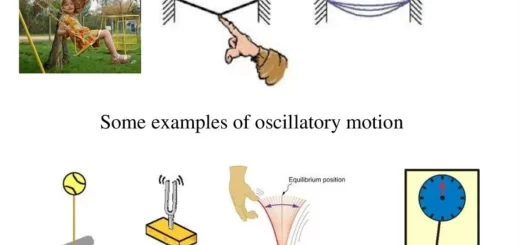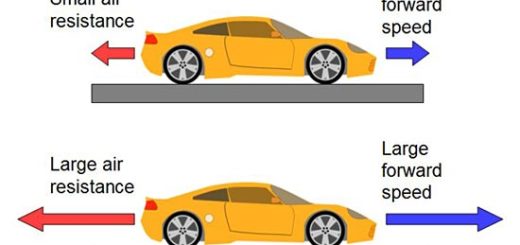Compton effect, Photon properties, Electron microscope and Optical microscope
Converting the mass (m) into energy (E) is related to the Einstein relation (E = mc²) which is the scientific base of the nuclear bomb where it was found that the fission of the nucleus is associated with losing very small mass and changing into very huge energy as the square of the light velocity is very large quantity (c² = 9 × 1016 m² / s²).
Compton effect
When a photon (from X or γ rays) falls on a free electron, The photon frequency decreases and the photon changes its direction, The electron velocity increases and it changes its direction and this phenomenon is called the ” Compton effect “.
This observation could not be explained by the classical theory of light but can be explained based on Planck’s hypothesis that electromagnetic radiation consists of photons that can collide with electrons as billiard balls collide (elastic collision).
Sum of the linear momentum of photon and electron before collision = Sum of the linear momentum of the photon and electron after collision (law of conversation of linear momentum)
The sum of the energy of the photon and electron before collision = The sum of the energy of the photon and electron after collision (law of conservation of energy)
We find that Compton’s effect proves the particle properties of light, we conclude that the photon moves as a particle that has mass and velocity (linear momentum) as well as the electron which proves the particle nature of light, The classical physics could not explain it and it could not be explained except by assuming the existence of photon.
Photon properties
- It is a quantum of energy (h ν) its value depends on the frequency (ν): E = h ν = h c / λ).
- It has a mass (m) during its motion: m = E / c² = h ν /c² = h / λ c
- It moves with the velocity of light (c) in the space.
- When the photon stops its motion, its mass changes into energy gained by the body which stops it.
- It has linear momentum (PL): PL = mc = E / c = h ν / c = h / λ
- It has the wave-particle duality, So the two conservation laws of mass and energy are applied.
The electron is a particle with a negative charge & has a wave nature, It could be accelerated (increasing its velocity) by an electric field, it has a linear momentum PL = mv = h / λ, When it stops, it keeps its mass and loses its kinetic energy, It has mass during motion and rest (me = 9.1 × 10−31 kg).
The photon is a quantum of energy (hν) that has no charge & has a particle nature, It can’t be accelerated and it has constant velocity in space (3 × 108 m/s), it has a linear momentum PL = mc = E / c = hν / c = h / λ, When the photon stops and comes to rest, its mass changes into energy (E = m c²), It has mass just during motion m = E / c² = hν / c² = h / λc.
Deduction of the force produced due to the falling of photon beam on a surface
When a beam of light of frequency (ν) falls on a surface then reflects:
- The linear momentum of incident photon = mc
- The linear momentum of reflected photon = − mc
- The change of the linear momentum due to its reflection = 2 mc = 2 h ν / c
If a beam of photons is incident on a certain surface at the rate of (φL) (photon /sec), then each photon falls on the surface and reflects, causing a change in linear momentum.
The rate of the change of the linear momentum of photon beam = 2 mc φL = 2 φLh ν / c, which equals the force applied by photon beam on the surface:
F = 2 φLh ν / c
Pw = h ν φL
Where: (Pw) is the power in watts of the incident light on the surface
∴ F = 2 Pw / c
The relation between the wavelength of a photon and its linear momentum
λ = c / ν , By multiplying both the numerator and denominator by Planck’s constant ( h ):
λ = h c/ h ν
λ = h / ( h ν /c ) , PL = h ν / c
λ = h / PL
So, The wavelength of a photon equals the ratio between Planck’s constant and the linear momentum of a photon.
The macroscopic and microscopic models of light
When photons fall on a surface, then if photons wavelength (λ) is close to the intermolecular distances, then photons penetrate through atoms and this is what happens in the case of X-rays, The microscopic particle model of light is applied in this case.
When photons fall on a surface, then if photon wavelength (λ) is much larger than the intermolecular distances, then photons deals with this surface as a continuous surface and reflect from it, The macroscopic wave model of light is applied in this case.
So, the macroscopic model and microscopic model are coherent to each other and so, the wave and the particle properties of photons are adjacent also.
Comparison between the microscopic model and macroscopic model for light
The particle model of light (microscopic) is applied when an obstacle in the dimensions of an atom or electron has obstructed photon path, It studies the individual photon separately as a ball of radius equals the wavelength of the wave (λ) and vibrates in the frequency (ν).
The wave model of light (macroscopic) is applied when an obstacle of dimensions much larger than the wavelength of the wave has obstructed the photons’ path, it studies the photons’ stream as a whole in the form of a wave has a magnetic field and electric field perpendicular to each other and to the direction of their propagation.
Wave properties of a particle
De-Broglie has proved that as waves have a particle nature, particles have a wave nature such that a moving particle is accompanied by a wave its wavelength can be deduced as follows:
λ = c / ν
λ = h / PL
λ = h / m v
De-Broglie equation for particles: The wavelength of a wave accompanying a moving particle equals the ratio between Planck’s constant and the particle’s momentum.
The factors affecting the wavelength associating a moving particle
- The mass of the particle (m), (inversely proportional).
- The velocity of the particle (v), (inversely proportional).
So, the wave nature for light and electrons is as follows:
The wave nature of light
- Light is an enormous group of photons that has an associated wave that describes its behavior of propagation, reflection, refraction, interference & diffraction.
- The individual photon seems as if carrying the genetic recipes of the wave (the same properties of photons group) in terms of frequency, wavelength & velocity.
The wave nature of the electrons
- The beam of electrons is an enormous group of electrons which has an associated wave that describes its behavior.
- The electron seems as if carrying all the genetic recipes (the same characteristics of the electrons group) in terms of the mass, the charge, rotation around itself (lapping spin) and the linear momentum.
- The wave which accompanies the moving electron has a frequency, velocity, wavelength and characteristic of propagation, reflection, refraction, interference & diffraction.
We can use an electron ray as we use a light ray, This is the base of the electron microscope.
The electron microscope
To form an enlarged image of small objects, it is necessary that the wavelength of the used wave in photography to be less than the dimensions of the body to be configured and the wavelength of the normal light has limited dimensions, so the optical microscope can’t be used to see very small objects such as viruses.
The wave nature of the electron
Accelerating a bundle of electrons liberated under a high potential difference (V) and the velocity of the liberated electrons can be determined from the relation:
K E = ½ me v² = e V
We can calculate the wavelength of the wave which is associated the motion of the electron by using the De-Broglie equation: λ = h / mv
So, by increasing the potential difference between the cathode and anode in the electron microscope its kinetic energy increases the velocity of the electron (v) increases, the wavelength (λ) of the wave which is associated with the electron decreases until it becomes less than the dimension of the body, so a magnified image is formed.
So, the electron microscope is considered from the instruments that depend on the wave-particle duality for the electrons, The optical microscope and the electron microscope are similar in different fields as:
Optical microscope: The used beam is a light beam, The used lenses are glass lenses to concentrate the light on the body to magnify it, resolving power is low, and magnification power is limited as it fails to distinguish the fine details.
Electron microscope: The used beam is an electron beam with a wavelength shorter than the wavelength of the light beam by 1000 times, The used lenses are electronic (magnetic) lenses to focus the electron beam on the body to magnify it, resolving power is high as the electron can carry high kinetic energy and hence very short wavelength (λ), so it can detect very small objects that the normal light fails to observe, magnification power is very high, so it can distinguish the fine details.
You can download the application on Google Play from this link: Science online Apps on Google play
Thermal emission, photoelectric effect, Cathode ray tube & Photoelectric cell
Types of atomic spectra, Postulates of Bohr model and Spectrometer



